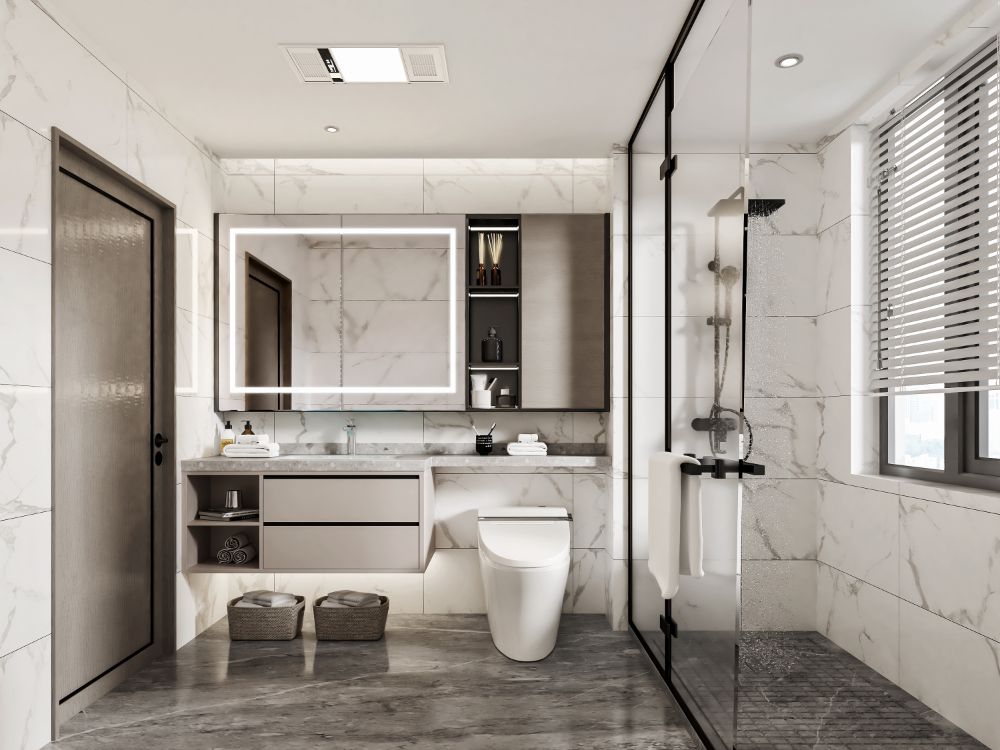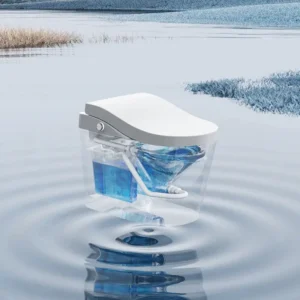Introduction
If you’re involved in the sanitaryware supply chain, you’ve probably noticed the tectonic shift happening in the modern bathroom. The days of simple porcelain fixtures are long gone; today’s consumers—especially in the residential market, which drives 77.2% of applications—are demanding sophistication, hygiene, and integrated technology. For wholesalers, distributors, and retailers, this presents both an incredible opportunity and a complex logistical challenge. How do you optimize your inventory to meet this surging demand while managing the radically different components and cost structures of a wall-hung smart toilet versus an integrated one-piece unit? It’s a tightrope walk between design trends and logistics reality, and getting it right is crucial for success.
The Smart Toilet Revolution: Why Inventory Optimization Matters
If you’re involved in the sanitaryware supply chain, you’ve probably noticed the tectonic shift happening in the modern bathroom. The days of simple porcelain fixtures are long gone; today’s consumers—especially in the residential market, which drives 77.2% of applications—are demanding sophistication, hygiene, and integrated technology. For wholesalers, distributors, and retailers, this presents both an incredible opportunity and a complex logistical challenge. How do you optimize your inventory to meet this surging demand while managing the radically different components and cost structures of a wall-hung smart toilet versus an integrated one-piece unit? It’s a tightrope walk between design trends and logistics reality, and getting it right is crucial for success.
Decoding the Designs: Wall-Hung vs. One-Piece Smart Toilets
The foundational difference in your inventory strategy comes down to design: the floating, futuristic Wall-Hung model versus the reliable, classic One-Piece unit. Understanding the consumer drivers for each is essential for predicting sales velocity.
The Minimalist Marvel: Understanding Wall-Hung Appeal
Wall-hung toilets are the darlings of modern, minimalist design, offering a cleaner, lighter aesthetic with a sleek, concealed cistern. They create an illusion of more floor space—a huge benefit in urban and small-space settings, where compact models are seeing rising adoption. Who doesn't want their bathroom to look bigger? Moreover, the ease of cleaning the entire floor area beneath and around the fixture is a major selling point for maintenance-conscious customers. This style dominated the "type segment" in 2024, holding a 33.4% share. Customers choose these for aesthetics, space-saving capabilities, and the highly desirable adjustable height feature.
The Timeless Classic: The One-Piece Advantage
In contrast, the one-piece toilet is the embodiment of simple reliability. Combining the tank and bowl into a single, seamless unit, they offer a sleek design that is generally easier to install and maintain than their wall-hung counterparts. While perhaps not as avant-garde, they are sturdy, reliable, and fit perfectly into both traditional and contemporary settings. For shoppers prioritizing an all-in-one, straightforward hygiene solution, integrated smart toilets (which are often one-piece designs) led the category segment in 2024 with a 59.6% share. They represent the great middle ground: stylish, easy to maintain, and more affordable than high-end wall-hung smart models.
The Inventory Tightrope: Logistics and Cost Implications
When stocking these two types, your logistics team faces fundamentally different challenges. The complexity of the wall-hung unit dramatically affects procurement, storage, and customer support.
The True Cost of Wall-Hung: Decoding Installation Economics
A common misconception is that the toilet itself is the main cost factor. While the fixture's cost may be similar to its floor-mounted equivalent, the carrier system—that strong, essential metal assembly bolted to the floor behind the wall—adds significantly to the overall expense. Furthermore, installation is inherently complex. Retrofitting a bathroom requires special framing, concealed tanks, and rerouted plumbing, often pushing the total installed cost to $800–$2,500, compared to just $350–$500 for a floor-mounted model. This higher cost must be factored into your margin calculations and presented clearly to your sales channel partners.
Consumer Perception: Why the Price Premium is Justified
Why do customers willingly pay twice as much for a wall-hung unit? They are buying a complete design transformation. They are paying for a minimalistic aesthetic, easier cleaning access, the psychological benefit of more floor space, and the quiet operation that comes from the in-wall tank muffling the sound. Your inventory must support this value proposition, ensuring high-quality components that justify the expense.
Stocking the Multi-Component System: The Wall-Hung Supply Chain Challenge
A wall-hung toilet isn't just one item; it is, quite literally, "only a small part of a much larger system". To fulfill a single wall-hung order, your warehouse must ship multiple, distinct components: the smart toilet fixture, the metal carrier assembly (often cast iron), and potentially a concealed cistern/tank. This is a major contrast to the single-box fulfillment of a one-piece unit. Failing to stock the carrier system correctly means holding stranded inventory of the toilet fixture itself.
The Critical Role of Warehouse Management Systems (WMS)
This multi-component reality mandates the use of a sophisticated Warehouse Management System (WMS). You need real-time, comprehensive visibility into
every single SKU (fixture, carrier, plumbing) to ensure every part of a wall-hung system is picked and packed in perfect harmony before shipment, streamlining everything from receiving to packing.
Reverse Logistics: Mitigating Returns for High-Value Smart Fixtures
Returns—the supply chain's "dirty secret"—are especially costly with high-value, complex smart fixtures. Since reverse logistics is more complex than forward logistics, effective management is essential for profitability. Your strategy must include returns mitigation: use crystal-clear product descriptions, accurate specifications, and implement robust pre-shipment quality checks to eliminate defects and confusion before the product leaves your dock.
Strategic Stocking: Maximizing Profitability
To truly optimize inventory, look past the basic model type and focus on the features that guarantee higher margins and increased consumer interest.
Focus on High-Demand Features: Prioritizing Integrated and Wi-Fi Connected Units
Integrated smart toilets and Wi-Fi-connected models clearly lead the market. Therefore, your buying power should favor integrated solutions that feature bidets, which align strongly with consumer demands for hygiene and convenience. Stocking products that offer a complete, modern, hands-free experience is paramount.
The Sustainability Factor: Stocking WaterSense Certified Models
Attract the growing segment of sustainability-conscious buyers by prioritizing WaterSense labeled toilets. These high-performance, water-efficient models often qualify for utility rebates, which can significantly lower the final price for the consumer and drive greater sales volume.
Addressing Durability Concerns: Post-Sale Maintenance and Longevity
Smart toilets, as advanced electronics, are subject to common issues like electronic malfunctions, clogged bidet nozzles from mineral deposits, and power supply problems . A successful inventory strategy includes stocking essential consumables. By having replacement water filters and other manufacturer-recommended parts available, you enhance customer satisfaction, reduce service calls, and improve the long-term perceived value of the product .
The Future of the Bathroom is Smart and Sleek
Whether your customer chooses the integrated reliability of a one-piece unit or the sophisticated, space-saving wall-hung design, the demand is firmly centered on smart technology, seamless aesthetics, and durable performance. Optimizing your inventory requires a dual approach: logistical precision to manage the multi-component wall-hung system and a strategic focus on high-demand, feature-rich integrated models. Master these dynamics, and you’ll secure your leadership role in the competitive sanitaryware market.
Summary and Frequently Asked Questions (FAQs)
In summary, the modern bathroom trend is defined by smart technology and sleek design, driving demand for both reliable one-piece and minimalist wall-hung smart toilets. For inventory management, the critical distinction lies in logistics: the one-piece unit is simple to stock and ship, whereas the wall-hung model requires meticulous component tracking—fixture, carrier system, and cistern. By prioritizing high-demand features like integrated bidets and Wi-Fi connectivity, mitigating returns through quality assurance, and supporting post-sale durability with maintenance components, you ensure your inventory maximizes profitability in this booming market.
5 Conclusion-Related FAQs
Q1: How significantly does the wall-hung carrier system impact overall inventory costs compared to a one-piece unit?
The wall-hung carrier system adds a substantial cost layer. While the toilet fixture cost is similar, the necessary carrier assembly and the complexity of installation (special framing/plumbing) drive the total installed price to $800–$2,500, which can be more than double the cost of a standard floor-mounted option. Inventory must account for stocking this specific, high-value component.
Q2: What is the single most important action a distributor can take to reduce the high return rate associated with smart toilets?
The most impactful action is ensuring precision from the first click by implementing stringent pre-shipment quality control and using absolutely clear, detailed product listings. Returns are frequently caused by quality issues (approx. 20%) or inaccurate product information. Clear specs and robust checks eliminate defects and build consumer trust.
Q3: Which feature category should be prioritized when stocking smart toilet inventory for maximum market capture?
Prioritize integrated, Wi-Fi-connected smart toilets with bidet functionality. Integrated units led the category segment in 2024 (59.6%), and Wi-Fi dominates connectivity (68.1%). These features align directly with consumer demand for convenience, hygiene, and modern design.
Q4: How does stocking WaterSense certified models benefit the retailer or distributor?
Stocking WaterSense certified models appeals directly to sustainability-conscious buyers. More critically, these high-performance, water-efficient products often qualify for local utility rebates and vouchers, which lowers the out-of-pocket cost for the end consumer and boosts your sales volume without requiring you to offer deep discounts.
Q5: Beyond the initial sale, what must inventory managers consider regarding the long-term durability of smart toilets?
Inventory managers must stock critical maintenance components. Smart toilets are susceptible to electronic malfunctions and clogged bidet nozzles . By having replacement water filters and manufacturer-recommended parts available, you help customers maintain the unit's longevity and performance, ensuring it remains a valuable investment and reducing future service calls .


